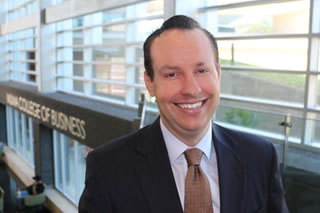News Archive
Capstone Class Looks at USF Consolidation, Makes Marketing Recommendations
By Keith Morelli

TAMPA (June 17, 2019) -- The project undertaken by students in the spring marketing capstone project was close to home.
The course, which is the culmination of a marketing sequence for seniors, focused their attention on the University of South Florida’s effort to consolidate three campuses in Tampa, St. Petersburg and Sarasota-Manatee. More specifically, the project sought to come up with recommendations for how the Muma College of Business, with implications for the larger university, markets its programs to students from all over West Central Florida and beyond.
“This was an example of the sort of analytics-based, creative, real-life project we strive for,” said Rob Hooker, associate professor in the marketing department who taught the capstone course. “It forced the students to apply their knowledge to dynamic decision-making environments, while leveraging a fusion of geo-fencing, social media analysis and other data-collection techniques.”
The effort was facilitated in collaboration with SiteZeus, an artificial intelligence-powered location intelligence company cofounded by USF alumni and brothers Hannibal and Keenan Baldwin. Drew Wagner, who received a bachelor’s degree in marketing from USF in 2017, was also heavily involved in mentoring students on the project.
“It is exciting to see the platform that we built for retail site selection now assist in the decision-making process for the university,” said Hannibal Baldwin, CEO of SiteZeus.
The consolidation, mandated by the Florida Legislature a year ago, pulls the university together under one umbrella and a single accreditation. The initiative brings with it untold details that need to be worked out. For example, no longer will there be three separate business colleges on the three campuses.
Some details about how business professors in Tampa will teach courses in St. Petersburg are still being finalized. Hospitality courses that are offered exclusively on the Sarasota-Manatee campus must now, depending on student demand, be offered in Tampa and accounting courses offered in Tampa now must be offered in St. Petersburg. Among the unanswered questions: Where are the students coming from now to take these courses? Do they live near the campuses where they take the classes? Do they travel great distances in difficult traffic to take classes on a campus that is 40 miles away?
The work done by the students has uncovered some of the answers and that data could assist USF in deciding what courses to offer and where.
Among the recommendations/findings:
- USF could leverage information about desirable majors in various campus locations, combined with data of the most heavily trafficked areas around Tampa Bay, to improve marketing efforts. Marketing could involve billboard or mobile devices.
- Traffic patterns and heat maps may be helpful in optimizing class times and/or structure of student groups for projects.
- Lifestyle trends across the three campuses indicate perceived differences that may impact “student fit” following admission to the university. According to the survey, the Tampa campus is perceived as a base for cutting-edge research versus St. Petersburg, which is perceived as being heavily influenced by social trends versus Sarasota-Manatee, seen as being more intimate in its classroom experience.
- Students, the surveys showed, were very open to online and/or hybrid formats for certain courses.
Focusing on the students attending courses on all three campuses, the capstone class sought to determine just who those students are, where they live, how far they travel for their education.
Hooker said he plans to share some of the information from the research with the Marketing Department Undergraduate Programs Committee, where it will be prepared for use in marketing classes and eventually to the college’s programs committee.
And SiteZeus’ location intelligence solution played a big role in acting as a sounding board for the collected data and analysis.
“Students were asked to create a data-driven report created in Adobe InDesign, complete with data visualizations, recommendations and an accompanying presentation for SiteZeus executives,” Hooker said. “Capstone students used the SiteZeus platform, as well as data collected from students and administrators from all three USF campuses through surveys and interviews.
“All of the data was triangulated and analyzed through Tableau and other tools to construct recommendations for both USF and SiteZeus,” Hooker said.
Here are some of the questions the cohort was asked to examine:
- Where are students, attending classes across various campuses, currently living?
- Are there any “outlier” students travelling farther than expected for classes that may only be offered at a single campus?
- Where and how is USF currently targeting them through the use of traditional marketing methods? Is this the ideal way to market towards these students?
- What data or features could SiteZeus incorporate into the platform to make it a premier marketing tool?
The quality of work we received from the students who worked with Dr. Hooker was impressive,” said Hannibal Baldwin. “The insights that the students shared were actionable. They revealed additional benefits to the platform that we are considering for the future.
“We look forward to further collaboration.”